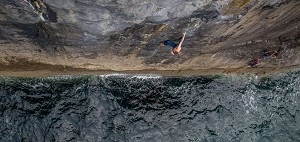
Eimir McSwiggan had very successful UIAA Ice Climbing World Cup season in 2017 - winning Bronze and Silver in Durango (USA) and Cheongsong (KOR) respectively. The 38 year-old didn't have a typical introduction to ice climbing, though: a move from County Tyrone in Northern Ireland to South Korea in 2010 to start work as an English teacher provided a chance encounter with the sport.
Having finished 5th overall in the 2017 World Cup series, I sent Eimir some questions to find out a bit more about this talented climber whom you've probably never heard of...
'I remember looking at the climbing wall when I was at university, but sort of wrote it off for myself thinking I wouldn’t have the right body type or upper body strength for it. How I regret that now!'
How did you end up in South Korea?
I had been working as an architect in Dublin before moving to South Korea. With the downturn in the economy at the time I was looking for a short term change in career and decided to move to Korea initially just for one year.
How did you discover ice climbing?
I was first introduced to ice climbing at the 2011 Ice Climbing World Cup in Korea. It was the first year the World Cup was being held in Korea so it was big news at the time and I went there just as a spectator to see what all the fuss was about. There was a little beginner ice wall there where I had a chance to try out crampons and ice axes for the first time. It felt very awkward and strange but I was intrigued. I started climbing natural ice then and the same season I went to climb Towangseong Ice Falls, a 350m vertical ice wall deep in the heart of Seoraksan National Park in South Korea. I was mesmerized by the ice falls from first glimpse. The approach and climb took our team 21 hours to complete and I really struggled on it with limited ice skills, but it was one of those life changing experiences and I was determined to get strong for the next season.
Were you into rock climbing/another type of climbing or outdoor sport previously?
I grew up on a farm and always loved being outdoors but had no idea of the climbing scene that existed at home. I do remember looking at the climbing wall when I was at university but sort of wrote it off for myself thinking I wouldn’t have the right body type or upper body strength for it. How I regret that now!
I first tried natural rock climbing when I was travelling in Australia in 2008. I loved it instantly. Then when I moved to Korea I stumbled across a beginner multi-pitch climbing course which introduced me to the Korea climbing scene. I joined a Korean climbing gym who introduced me to hard training and also to all the most beautiful climbing areas all over Korea.
Where were you practising ice climbing before doing competitions - was it on natural ice falls or on a purpose-built facility?
I climbed on natural ice for 2 years before I got into the competition scene. With guaranteed cold dry winters ice climbing is a really popular sport in Korea, with a lot of natural ice falls in the mountains and also outdoor ice parks with up to 100m high walls of ice farmed from rivers below. Since starting competitions, I’ve trained predominantly on dry tooling holds in an indoor bouldering gym throughout the autumn and for the weeks preceeding competitions try to get out to the outdoor artificial dry tooling wall as much as possible. I also climb as much ice as I have time to do. I do a lot of biking and running too for aerobic training also.
When did you start to consider joining the international competition circuit - did you compete nationally too?
When my coach Kim Jong Heon first suggested that I train to compete in the Korean leg of the World Cup I sort of laughed it off. But as time went on, I started to think, why not? I was already living in the country, would be able to learn from one of the best ice climbers in Korea and in the end it seemed like an opportunity I couldn’t pass up on. I contacted Mountaineering Ireland for permission to compete and although they seemed somewhat surprised they were supportive. I was also very lucky to have the chance to take part in the two National Ice Climbing competitions that year, a rule which has unfortunately since changed to limit participation to Korean nationals only.
Where was your first international competition, and how did you get on? Was it intimidating?
My first International competition was at the World Cup in Cheongsong in 2013. I had been training hard for 3 months mostly on dry tooling routes in an indoor bouldering gym and on natural ice when the winter arrived. I had also studied all the videos from the previous year and done as much as I could to prepare. Arriving at the venue, I felt completely intimidated though and remember thinking, 'Maybe I should run away instead of going into the isolation tent?' But I soon learned that the competition ice climbers are one of the warmest, most welcoming group of people I have ever met. Everyone was full of advice and encouragement. My climb itself was a bit of a blur but I made it about half way up the qualification wall before pinging off. I was amazed at how graceful the other climbers were, making it all look so easy. I was already excited to start training for the next year.
Tell us about your fall in 2015 - how did you get back to fitness?
In July 2015 I took an unlucky fall against a ledge whilst rock climbing in Korea, which put me out of action for a few months. I had a broken heel bone and severed two ligaments and would require surgery and stabilisation pins. Thankfully, it happened right at the end of the spring climbing season before the summer monsoon and I already had a good season of climbing behind me. The surgery was a success and the doctor said I would make a full recovery. I couldn’t stay out of the gym long though and was back there within a week. I spent the next 6 weeks working mainly on upper body strength and a little easy climbing. Soon after I got the cast off and was getting back on my feet I got an invite from Scott Muir to take part in the Red Bull White Cliffs Challenge a few weeks later. There was no way I could turn this opportunity down and did everything in my power to get myself back in good condition. I swapped running for biking and did as many rehabilitation exercises as possible, and it all worked out.
'Koreans really appreciate hard work and if you are willing to train hard they generally give you as much assistance as they can to help you succeed in your goals. There is no doubt that without this, I would not be where I am today.'
Tell us a bit about your 2017 season so far - you've been picking up some medals! What contributed to this - training more specifically, working on your mental approach or something else?
2017 has turned out to be a great season for me, making it into 5 out of the 6 finals, winning two World Cup medals and finishing the season with an overall world ranking of 5th place. I’ve always trained hard for the competitions, but this year I definitely stepped it up a gear. I took a radical decision in early Autumn to quit my permanent teaching job, move out of my apartment into basic accommodation and put all my focus on training and preparing for this season. It was a big decision to make, but I thought that if I didn’t give it my best shot this year I would regret it. I did question my sanity on quite a few occasions, living on my own so far away from home in a little cubicle room, letting this crazy climbing dream take over my life. But as it turned out for this season’s competitions it made all the difference in the world for me.
How has living in South Korea benefitted your training? Are there specific coaches, camps and facilities?
Climbing is big business in Korea, with over 500 climbing gyms and numerous public outdoor sport climbing structures across the peninsula. Most gyms like the one I go to are small bouldering style gyms with very tight knit communities. There is a great sense of mentorship within these communities. I train at Kim Jong Heon Climbing Center in Anyang, a gym famous within the ice climbing community and also the foreign community living in Korea for its welcoming atmosphere and expert coaching. Koreans really appreciate hard work and if you are willing to train hard they generally give you every assistance they can to help you succeed in your goals. There is no doubt that without this, I would not be where I am today. At present Korea are leading the field in terms of competition lead ice climbing, with gold medals in both male and female categories in 5 out of 6 of this year’s competitions, so they are definitely the ones to follow.
How do you fund your competition travels? Do you receive any support?
I’ve always worked and saved hard during the year for the competition season. For the past two seasons I have also been lucky to receive funding from SportNI through Mountaineering Ireland to help with travel costs to the World Cup series. With 6 competitions in total across three different continents, requiring almost 2 months off work the cost of competitions can escalate quickly but in order to develop in the sport I think it’s vital to be able to compete in as many competitions as possible.
Where would you recommend as an ice climbing destination in South Korea?
The most concentrated area of quality natural water ice falls is located in Seoraksan National Park. Towangseong Ice Falls, the highest ice climb in Asia, a 350m WI5 giant, is the most sought after climb here, though it’s recommended to go there on weekdays to escape the crowds and falling ice. There are also a number of other equally high quality ice falls in the area of varying degrees of difficulty and length. Seoraksan also has a number of alpine style winter ridge routes as well which are worth a visit. The season runs from early January to late February, though it has been more unpredictable the last few years due to warmer weather.
Will you be moving back to N. Ireland anytime soon? Have you experienced much of the rock climbing there?
I am in the process of moving back home at the moment. I’ve been living in Korea for almost seven years now and although it’s an amazing country it is definitely time to take some time out. I am really excited to check out the rock climbing scene there. Most of my rock climbing experience the past few years has been on sport and bolted routes and I am eager to learn some new skills and get more involved in the trad climbing scene.
Do you hope to inspire more people to take up the sport back in N. Ireland?
I am always very eager to get more people involved in the sport and am eager to share the skills and knowledge I have picked up with climbers back home. With the prospect of ice climbing becoming an official Olympic Sport in 2022 I think there are very exciting times ahead. This year I had the chance to judge at the Youth Ice Climbing Championship in Champagny-en-Vanoise in France as part of the UIAA aspirant judge’s course. I was truly amazed at the skill level and enthusiasm of the younger climbers and think we will see an incredible development in the sport over the next decade.
What are your goals for the rest of the 2017 season and beyond?
Right now I am trying to get in as much natural ice climbing experience in South Korea before I move back home. Finding a job will be my first priority after that, and whether or not I will get back into the architecture field, education or cross over into something else more related to climbing and the outdoors is yet to be decided. One thing for sure, I will still be climbing and training and hopefully starting to make plans for next year’s ice season.
- SKILLS: Top Tips for Learning to Sport Climb Outdoors 22 Apr
- INTERVIEW: Albert Ok - The Speed Climbing Coach with a Global Athlete Team 17 Apr
- SKILLS: Top 10 Tips for Making the Move from Indoor to Outdoor Bouldering 24 Jan
- ARTICLE: International Mountain Day 2023 - Mountains & Climate Science at COP28 11 Dec, 2023
- ARTICLE: Did Downclimbing Apes help Evolve our Ultra-Mobile Human Arms? 5 Dec, 2023
- ARTICLE: Dàna - Scotland's Wild Places: Scottish Climbing on the BBC 10 Nov, 2023
- INTERVIEW: Loki's Mischief: Leo Houlding on his Return to Mount Asgard 23 Oct, 2023
- INTERVIEW: BMC CEO Paul Davies on GB Climbing 24 Aug, 2023
- ARTICLE: Paris 2024 Olympic Games: Sport Climbing Qualification and Scoring Explainer 26 Jul, 2023
- INTERVIEW: Malcolm Bass on Life after Stroke 8 Jun, 2023



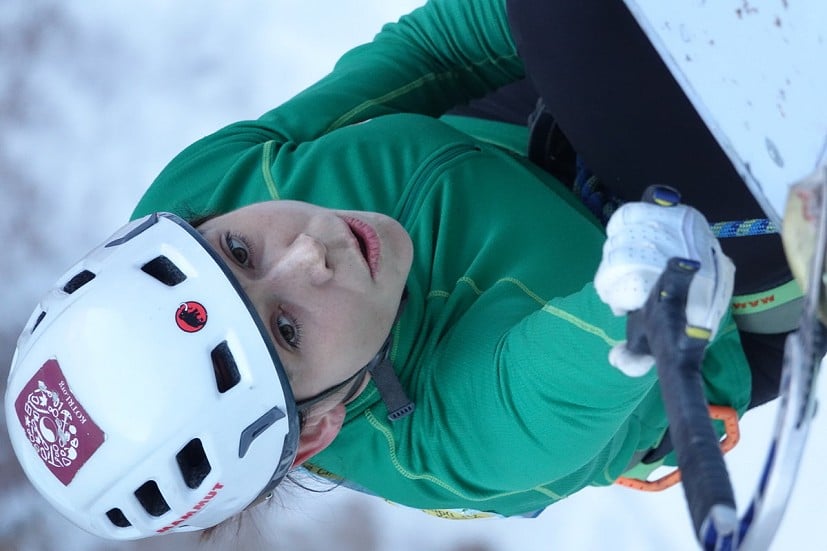

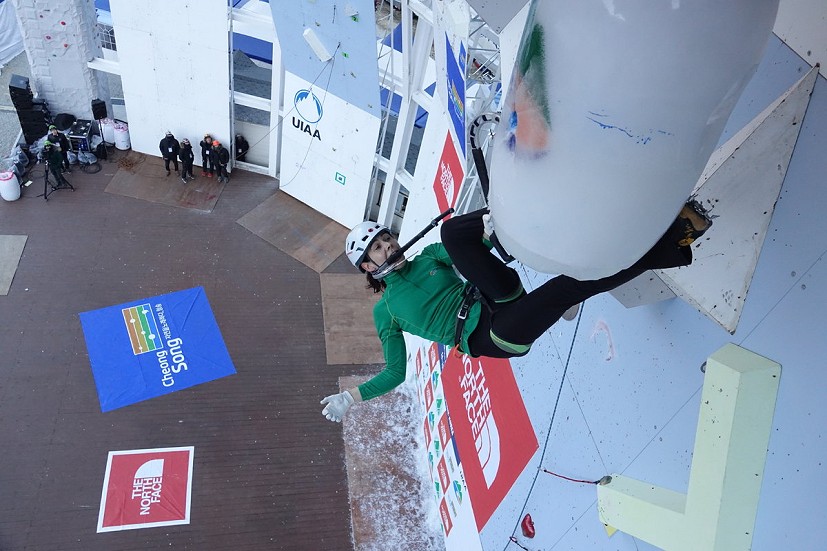

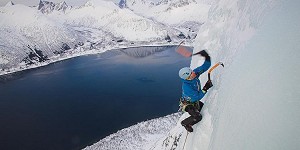

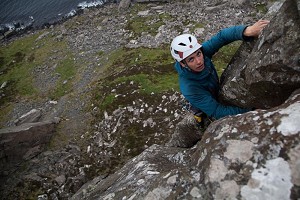







Comments